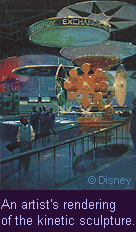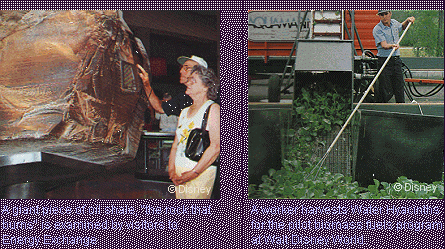 |
Home > Energy Exchange > Exhibits

 Energy Exchange, located in Communicore East, was a companion exhibit area for the
Universe of Energy. Here guests could discover more about the topics presented in
the Universe of Energy--from detailed information on energy sources and energy production
to energy conservation. Hands-on exhibits, films, video, text displays, models and more
were used to make energy concepts both understandable and fun for guests.
Energy Exchange, located in Communicore East, was a companion exhibit area for the
Universe of Energy. Here guests could discover more about the topics presented in
the Universe of Energy--from detailed information on energy sources and energy production
to energy conservation. Hands-on exhibits, films, video, text displays, models and more
were used to make energy concepts both understandable and fun for guests.
At Energy Exchange's main entrance (there were also two smaller side entrances) was a large
kinetic sculpture. A gentlly sloping ramp partially encircled the unique sculpture which
represented "energy in motion", with its revolving gears and wheels, lights, and other elements.
Exhibits dealing with specific energy resources were divided into four separate areas, each
centered around its own eye-catching centerpiece. These areas included:
Wind & Solar Power
 The Wind & Solar exhibit area revolved around central display of solar
cells. Spotlights mounted over the solar cells provided power, and allowed guests to visibly
see the reaction when they placed their hands over the solar cells, blocking the lights.
The Wind & Solar exhibit area revolved around central display of solar
cells. Spotlights mounted over the solar cells provided power, and allowed guests to visibly
see the reaction when they placed their hands over the solar cells, blocking the lights.
Nearby, situated perpendicular to one of the side entrances, was a display where guests could
learn about the photovoltaic cells on the roof of the Universe of Energy pavilion next door.
The display explained how the solar array partially powered the ride within. Two meters on the
display showed the electrical wattage produced by the cells, as well as the percentage of sunlight
exposure the cells were receiving.
A giant revolving windmill featured information on how windmills could play an integral role in
the future of energy production.

Nuclear Energy
One of the most intriguing of all of the exhibits at Energy Exchange was located in the heart of
the nuclear exhibit area. It was here that guests could try their hand at operating the "Nuclear Reactor."
A model of a nuclear reactor's control and fuel rod assembly stood in the center of the circular display.
By manipulating a lever on a console, guests could raise and lower the control rods. A monitor on the
console showed the effect of moving the control rods, with a "thermal display."
The perimeter of the circular display offered more information on how nuclear reactors work and generate
electrical power.
Nearby, another display showed guests that even common items-such as a smoke detector, antique glass,
and a photographer's anti-static brush produce radiation. For comparison, the display also featured a
small piece of Uranium. Guests could rotate a turntable containing these various items past a Geiger
counter, to see how radioactive they each were.

Fossil Fuels
At the heart of the Fossil Fuels exhibit area was an impressive and intricately detailed
scale model of an offshore drilling platform. Surrounding the model were several display cases that
featured drill bits as well as other pieces of equipment used on actual drilling platforms.
Another extraordinary feature of the fossil fuels exhibit area was an actual dragline bucket that was
used in coal strip mining operations. The bucket was so large, that guests could actually walk inside
of it and discover more about coal and coal mining in a mini "theater" located within.
Another display featured a number of test test-tubes filled with various types of crude oil. By pressing
a button, the tubes would shift from one side to another so guests could observe the viscosity of the different
oil types.

Synthetic Fuels
Dominating the Synthetic Fuels exhibit area was a giant piece of oil shale
(...the rock that burns). This exhibit area featured displays with information on different synthetic
and biomass fuels, as well as a number of display cabinets containing various examples of biofuels.

The "biomass" display at the back of the exhibit area featured a short video on the nature and use
of biofuels. It even showed the pilot program developed by Walt Disney World and other researchers,
for turning pesky, river-clogging Water Hyacinths into a biomass fuel source.

Other Exhibits
Lining the walls at each end of the display area were "Energy Access Terminals." These touch-screen
terminals offered in-depth information on current and future energy sources, conservation, and more.
Guests could take a self-paced, "guided tour" through the topics of their choice, by making selections
on the touch-screens. The topics played out as videos supplied by laser discs in the nearby EPCOT Computer Central.
"Mini-theaters" in the display area featured short video films on various energy topics, with seating for
around 8 to 10 guests.
 For information on energy consumption on the home front, the "Neon House" exhibit, which was located
beneath the frame of a "house" made out of neon light tubes, featured video monitors that gave guests
information on how they could conserve energy at home.
For information on energy consumption on the home front, the "Neon House" exhibit, which was located
beneath the frame of a "house" made out of neon light tubes, featured video monitors that gave guests
information on how they could conserve energy at home.
Another popular exhibit was "Video Bicycle." There, guests pedaled a stationary bicycle to generate
electricity. A video monitor displayed how much power the guest was generating through their pedaling
(hint: it takes a lot of pedaling to produce a small amount of electricity!). Guests could also test
their energy generating capabilities at the "Hand Generators" exhibit, where they could crank a handle
to try and generate enough power to illuminate a light bulb.
|
 |
 |
|
One of the most popular exhibits at Energy Exchange was "Taxi Game" in which guests would "drive" a
virtual automobile through a computerized cityscape. The game challenged guests to find the shortest
route to their destination, and showed them how their driving habits affect fuel economy. A display
above the game screens offered additional tips on how to save fuel.
|

 |
|
 |
 |

Epitaph
Sadly, Energy Exchange closed permanently in late January of 1994, when Communicore was
transformed into Innoventions. With it, and its counterparts in Communicore (FutureCom, Backstage Magic,
et al), went part of the original mission of EPCOT: to inform, educate, and inspire while entertaining.

|
 |
|
|





